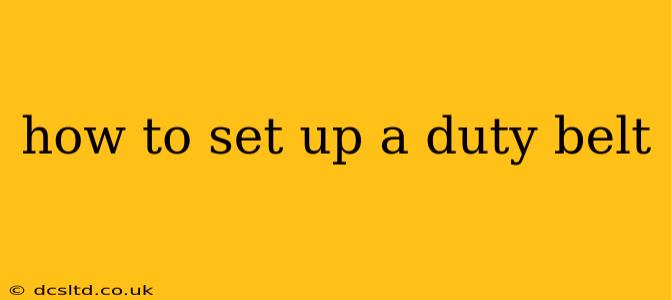Setting up a duty belt correctly is crucial for both comfort and efficiency. Whether you're a law enforcement officer, security professional, or someone who needs to carry multiple tools and equipment, a well-organized duty belt is essential. This guide will walk you through the process, covering everything from choosing the right belt to organizing your gear for optimal accessibility.
What type of duty belt should I choose?
The best duty belt for you depends on your specific needs and preferences. Consider the following factors:
-
Material: Leather belts offer durability and a classic look, while nylon belts are often lighter and more flexible. Some belts even incorporate a blend of materials for the best of both worlds. Consider the climate you'll be working in; leather can become uncomfortable in extreme heat and humidity.
-
Width: A wider belt (typically 2.25 inches or wider) provides more stability and distributes weight more evenly, preventing discomfort and reducing strain. Narrower belts might be more comfortable for lighter loads but can be less stable for heavier equipment.
-
Stiffness: A stiffer belt will hold its shape better, keeping your gear in place and preventing sagging. However, overly stiff belts can be uncomfortable. Find a balance between stiffness and comfort.
-
Adjustability: Look for a belt with a secure and easily adjustable buckle.
-
Padding: For prolonged wear, consider a padded belt or inner belt to increase comfort.
What is the proper order for items on a duty belt?
There's no single "correct" order, as the optimal arrangement depends on individual needs and personal preferences. However, prioritizing accessibility is key. Items you'll need frequently should be easily accessible, while less frequently used items can be placed further back. A common arrangement prioritizes speed and efficiency:
-
Handgun: This is usually positioned in a readily accessible holster at the front and center of your belt. The specific type of holster (inside-the-waistband, outside-the-waistband, etc.) will dictate placement.
-
Spare Magazine(s): These should be placed close to your handgun for quick reloading.
-
Taser/Stun Gun (if applicable): Position this for easy access, often on the opposite side of the handgun for balance and quick deployment.
-
Handcuffs: Place handcuffs within easy reach, typically on a swivel handcuff case.
-
Baton/Impact Weapon (if applicable): This usually goes on the opposite side of the handcuffs for balance.
-
Radio: Secure the radio in a sturdy pouch within reach, often on the side opposite the handgun. Consider a radio pouch that allows for quick access to the microphone.
-
Other Essential Tools: Items like a flashlight, knife, pepper spray, and other crucial tools should be strategically placed for quick access, considering their frequency of use.
How do I secure my gear to my duty belt?
Properly securing your gear is critical for safety and efficiency.
-
Use appropriate pouches and holsters: Invest in quality pouches and holsters designed specifically for your equipment. Ensure they fit snugly and securely.
-
Double-check attachments: Before each use, check all attachments to ensure nothing has come loose.
-
Avoid overcrowding: Don't overload your belt. Too much weight can lead to discomfort, fatigue, and decreased mobility.
-
Use retention devices: For critical items such as your firearm, consider holsters with retention devices to prevent accidental loss or removal.
What are common mistakes to avoid when setting up a duty belt?
-
Overloading the belt: A heavy belt will limit mobility and cause discomfort.
-
Poor placement of items: Items frequently needed should be easily accessible.
-
Using low-quality gear: Cheap pouches and holsters can fail at critical moments.
-
Inconsistent placement of items: Develop a consistent placement pattern to avoid confusion in stressful situations.
-
Neglecting comfort: Discomfort can lead to decreased alertness and reduced performance.
How do I maintain my duty belt and equipment?
Regular maintenance is essential for the longevity and effectiveness of your duty belt and equipment:
-
Regular cleaning: Clean your belt and pouches regularly to remove dirt, sweat, and grime.
-
Inspect gear: Regularly inspect your gear for wear and tear, replacing any damaged or worn items.
-
Lubricate moving parts: Lubricate moving parts on your holsters and other equipment to ensure smooth operation.
-
Proper storage: Store your belt and equipment in a clean and dry place to prevent damage.
By following these guidelines, you can set up a duty belt that is both efficient and comfortable, enabling you to perform your duties effectively and safely. Remember, practice makes perfect. Spend time practicing drawing your weapons and accessing your equipment so that you can perform these actions quickly and instinctively when needed.
